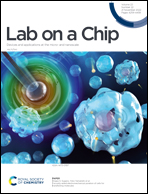High-performance blood plasma separation based on a Janus membrane technique and RBC agglutination reaction†
Abstract
Separation of plasma which is full of various biomarkers is critical for clinical diagnosis. However, the point-of-care plasma separation often relies on microfluidic filtration membranes which are usually limited in purity, yield, hemolysis, extraction speed, hematocrit level, and protein recovery. Here, we have developed a high-performance plasma membrane separation technique based on a Janus membrane and red blood cell (RBC) agglutination reaction. The RBC agglutination reaction can form larger RBC aggregates to separate plasma from blood cells. Then, the Janus membrane, serving as a multipore microfilter to block large RBC aggregates, allows the plasma to flow from the hydrophobic side to its hydrophilic side spontaneously. As a result, the separation technique can extract highly-purified plasma (99.99%) from whole blood with an ultra-high plasma yield (∼80%) in ∼80 s. Additionally, the separation technique is independent of the hematocrit level and can avoid hemolysis.



 Please wait while we load your content...
Please wait while we load your content...